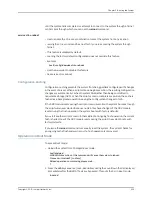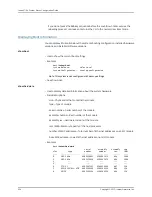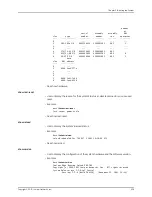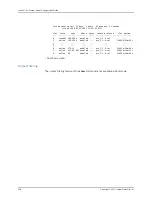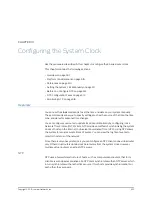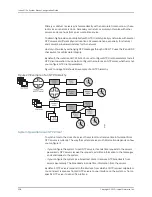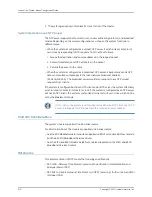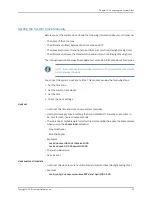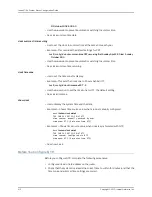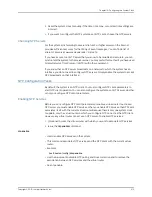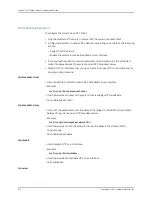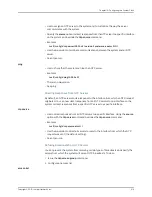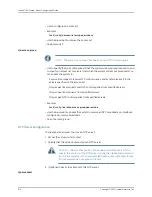
a state that could lead to a loss of configuration data or an NVS corruption, such as
during the synchronization of SRP modules, the system displays a message that
describes the state, and asks you to confirm (enter y for yes, n for no) whether you
want to proceed.
•
If you do not specify the
force
keyword, the procedure will fail if the system is in a state
that could lead to a loss of configuration data or an NVS corruption, and the system
will display a message that explains why the procedure failed.
•
Use the
standby-srp
keyword to reload the system software (.rel) file and the
configuration (.cnf) file on the standby SRP module without having to look up its slot
number to use with the
reload slot
command.
•
When you issue this command, the system prompts you for a confirmation before the
procedure starts.
•
If you remove a standby SRP module without issuing the
slot erase
command to delete
the configuration, the E Series router cannot guarantee that the SRP modules were
synchronized. In this situation, you must do either of the following to reload the router:
•
Issue the
reload
command with the
force
keyword.
•
Issue the
slot erase
command followed by the
reload
command.
•
Example
host1#
reload
host1#
reload force
•
There is no
no
version.
•
See reload.
reload
•
Use to reload the software on the system at an absolute time.
•
This command halts the system.
•
Reloads the system software (.rel) file and the configuration (.cnf) file on the system.If
the system is in a state that could lead to a loss of configuration data or an NVS
corruption, it will delay the procedure for one minute. Each time the system delays the
procedure, it adds a message to the os log that explains why the procedure was delayed.
If the system cannot reload on its sixth attempt, the reboot procedure will fail, and the
system will add an explanation to the os log.
•
Example
host1#
reload at 10:10 May 5
This command reloads the software 10 minutes after 10 on May 5th.
•
There is no
no
version.
•
See reload.
reload
501
Copyright © 2010, Juniper Networks, Inc.
Chapter 9: Booting the System
Summary of Contents for JUNOSE 11.3
Page 6: ...Copyright 2010 Juniper Networks Inc vi...
Page 8: ...Copyright 2010 Juniper Networks Inc viii JunosE 11 3 x System Basics Configuration Guide...
Page 24: ...Copyright 2010 Juniper Networks Inc xxiv JunosE 11 3 x System Basics Configuration Guide...
Page 32: ...Copyright 2010 Juniper Networks Inc 2 JunosE 11 3 x System Basics Configuration Guide...
Page 146: ...Copyright 2010 Juniper Networks Inc 116 JunosE 11 3 x System Basics Configuration Guide...
Page 166: ...Copyright 2010 Juniper Networks Inc 136 JunosE 11 3 x System Basics Configuration Guide...
Page 432: ...Copyright 2010 Juniper Networks Inc 402 JunosE 11 3 x System Basics Configuration Guide...
Page 488: ...Copyright 2010 Juniper Networks Inc 458 JunosE 11 3 x System Basics Configuration Guide...
Page 524: ...Copyright 2010 Juniper Networks Inc 494 JunosE 11 3 x System Basics Configuration Guide...
Page 554: ...Copyright 2010 Juniper Networks Inc 524 JunosE 11 3 x System Basics Configuration Guide...
Page 566: ...Copyright 2010 Juniper Networks Inc 536 JunosE 11 3 x System Basics Configuration Guide...
Page 588: ...Copyright 2010 Juniper Networks Inc 558 JunosE 11 3 x System Basics Configuration Guide...
Page 613: ...PART 3 Index Index on page 585 583 Copyright 2010 Juniper Networks Inc...
Page 614: ...Copyright 2010 Juniper Networks Inc 584 JunosE 11 3 x System Basics Configuration Guide...
Page 632: ...Copyright 2010 Juniper Networks Inc 602 JunosE 11 3 x System Basics Configuration Guide...

















